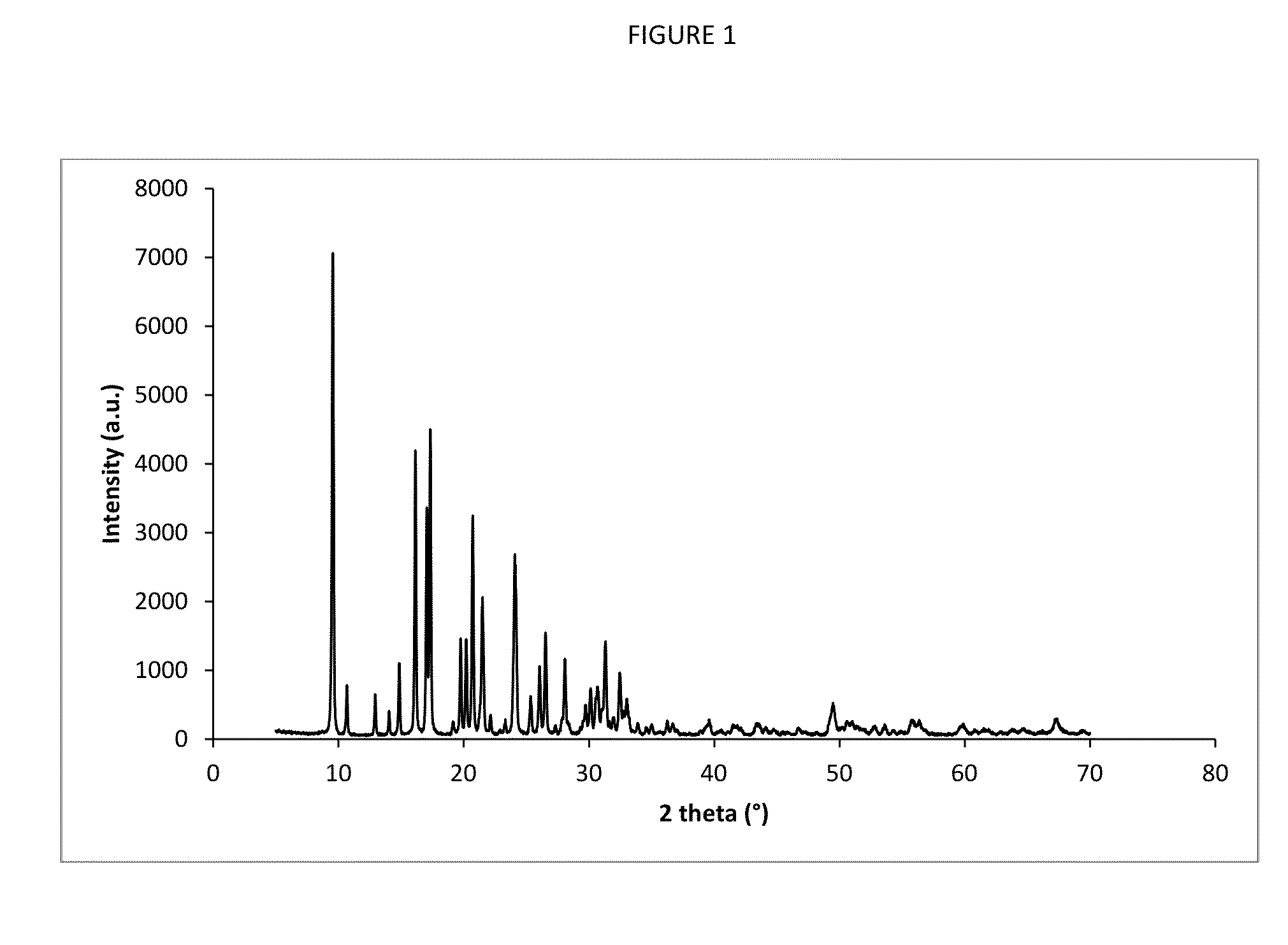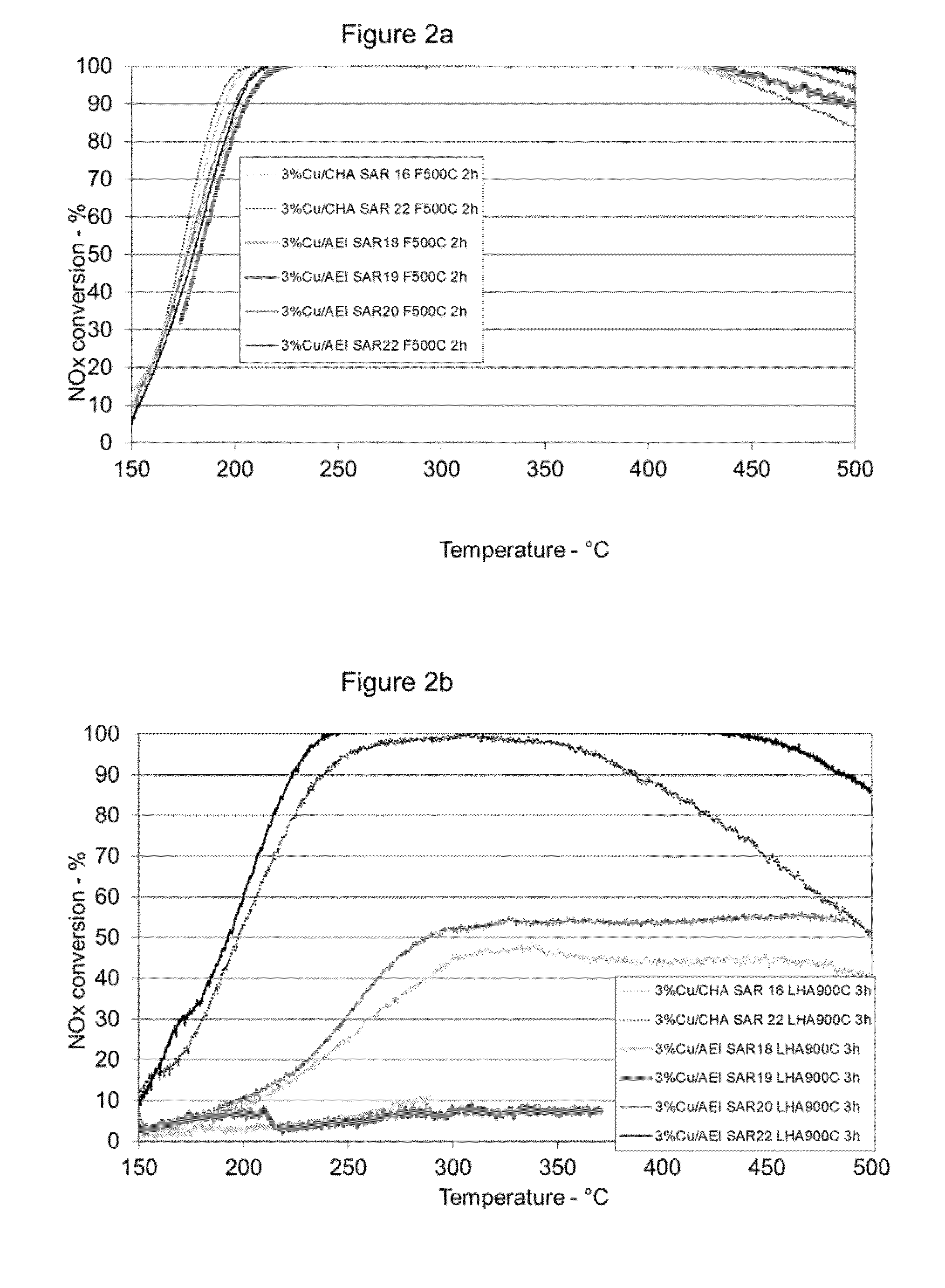Catalyst for treating exhaust gas
a technology of exhaust gas and catalyst, which is applied in the direction of physical/chemical process catalysts, arsenic compounds, separation processes, etc., can solve the problems of limiting the amount of metal that can be loaded, catalysts may become exposed to unexpected temperature spikes, and the reduction of nosub>x /sub>to nsub>2 /sub> is particularly problematic, so as to improve the catalytic performance
- Summary
- Abstract
- Description
- Claims
- Application Information
AI Technical Summary
Benefits of technology
Problems solved by technology
Method used
Image
Examples
example 1
Synthesis of AEI Zeolite (SAR=22)
[0074]A reaction gel of (molar) composition of 60 parts SiO2, 1.2 parts Al2O3, 13.41 parts Na2O, 9.5 parts N,N-diethyl-2,6-dimethylpiperidinium hydroxide (22.23 wt % solution), and 2721 parts H2O was prepared as follows: About 130.6 grams of a source of silica (30 wt % SiO2) was changed into a 1 Liter stainless steel autoclave with the agitator set to rotate at 300 rpm. About 341.4 g of 1N NaOH was mixed in a beaker with 98.3 g of the template. About 7.6 g of ammonium exchanged Y zeolite was added to this mixture. The mixture was stirred at room temperature for 10-15 min before being added to the colloidal silica in the autoclave. The autoclave was sealed and mixing continued, at room temperature, for a further 10 min before being heated to 135° C. The temperature was maintained for 12 days then the autoclave was cooled to room temperature, the product discharged then filtered, washed with demineralized water and dried at 110° C. overnight.
[0075]The ...
example 2
Synthesis of AEI Zeolite (SAR=20)
[0078]A reaction gel was prepared by a similar method and using reagents similar to that as that described in Example 1 above except that the template was a 22.23 wt % solution. In this case the reaction gel had a (molar) composition: 60 parts SiO2, 1.21 parts Al2O3, 15.0 parts Na2O, 9.5 parts template, and 2721 parts H2O. The reaction was carried out in a 1.5 L autoclave with stirring at 300 rpm. The reaction was carried out at 135° C. for 8 days before cooled to room temperature, discharged from the autoclave and filtered, washed and dried at 110° C. overnight.
[0079]The material was then activated in a manner to that described in Example 1 resulting in an H-AEI zeolite that was shown by XRD to be highly crystalline and by XRF to have an SAR of 20.
example 3
NOx Conversion Performance after High Temperature Aging
[0088]A 5 gram sample of AEI (SAR=22) aluminosilicate powder similar to that described in Example 1 was treated with copper acetate using an incipient wetness technique to produce a catalyst loaded with 3 weight percent copper. Copper loaded samples of AEI (SAR 18), AEI (SAR 19), and AEI (SAR 20) were prepared using similar techniques. In addition, a 3 weight percent copper loaded sample of an aluminosilicate having a CHA structure (SAR=16) and a copper loaded sample of an aluminosilicate having a CHA structure (SAR=22) were also prepared using a similar technique.
[0089]A portion of the material from each catalyst sample was hydrothermally aged at 500° C. / 4.5% water in air for 2 hours. After aging the powder samples were separately loaded into a synthetic catalyst activity test (SCAT) reactor and tested using a synthetic diesel exhaust gas mixture (at inlet) containing the following: 500 ppm NO, 385 ppm NH3, 10% O2, 10% H2O, bal...
PUM
| Property | Measurement | Unit |
|---|---|---|
| mole ratio | aaaaa | aaaaa |
| mole ratio | aaaaa | aaaaa |
| mole ratio | aaaaa | aaaaa |
Abstract
Description
Claims
Application Information
 Login to View More
Login to View More - R&D
- Intellectual Property
- Life Sciences
- Materials
- Tech Scout
- Unparalleled Data Quality
- Higher Quality Content
- 60% Fewer Hallucinations
Browse by: Latest US Patents, China's latest patents, Technical Efficacy Thesaurus, Application Domain, Technology Topic, Popular Technical Reports.
© 2025 PatSnap. All rights reserved.Legal|Privacy policy|Modern Slavery Act Transparency Statement|Sitemap|About US| Contact US: help@patsnap.com



